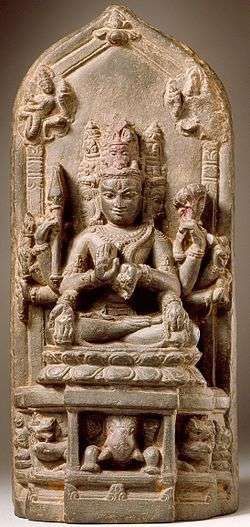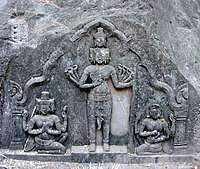Sadasiva
| Sadasiva | |
|---|---|
 Sadasiva from West Bengal. 11th c. CE | |
| Affiliation | Absolute Being, Shiva |
| Abode | Sadakya Tattva, Celestial Maha Kailasam |
| Mantra | Om Namah Shivaya |
| Symbols | Mukhalingam |
| Mount | Nandi |
| Consort | Manonmani[1] |
Sadashiva (Sanskrit: सदाशिव, Sadāśiva, Tamil: சதாசிவம் ), is the Supreme Being Lord Parashivam in the Mantra marga Siddhanta sect of Shaivism. Sadasiva is the omnipotent, subtle, luminous absolute. The highest manifestation of almighty who is blessing with Anugraha or grace, the fifth of Panchakritya - "Holy five acts" of Shiva. Sadasiva is usually depicted having five faces and ten hands, is also considered as the one of 25 Maheshwara murtams of Lord Shiva. Sivagamas conclude, Shiva Lingam, especially Mukhalingam, is another form of Sadasiva [2]
Iconography
The concept and form of Sadasiva initially emerged from South India, although many ancient sculptures of Sadasiva were obtained from various parts of India and South East Asia.[3] It is believed that the cult of Sadasiva was widespread in the region of Bengal during the period of Sena dynasty who traced their origin in South India.[4] Sadasiva is usually represented in the form of Mukhalingam with the number of faces varying from one to five. The first ever sculpture of Sadasiva as a lingam with five faces was found in Bhita, near Allahabad, and dates to the 2nd century CE. [3] His five faces, Ishana, Tatpurusha, Vamadeva, Aghora and Satyojata are known as Panchabrahmas (The five creators), the emanations towards the four directions and upwards from the nishkala (Formless) Parashivam. Kamiga Agamam, the first Agamam of 28 Sivagamas depicts Sadasiva as having five faces and ten arms. His five right hands hold Trishula, Axe, Katvanga, Vajra and Abhaya while his five left hands hold Snake, Matulunga fruit, Nilotpala, Damaru, Rudraksha rosary and Varadam.[5] The consort of Sadasiva is goddess Gayatri who is often known as Manonmani in Agamic texts.[6][1] She is sometimes depicted having two arms and residing in the lap of Sadasiva.
Panchabrahma
According to Shaivite texts, the supreme being Parashivam manifests as pentads apart from the well known Trinity of other Hindu sects - Brahma, Visnu and Shiva. His five deeds which are known "Panchakrityas" (holy five acts) are assigned to Panchamurti, his five aspects, viz., Brahma, Vishnu, Rudra, Maheshwara and Sadashiva. Creation, preservation, destruction, delusion and liberation are done by these five manifestations respectively. The five faces of Parashiva emanating these five aspects at whom we could not find any distinctions from himself, are praised as "Panchabrahmas", the five creators or the five realities. The Panchamurtis of Shaivism are absorbed within Shaktism and named as "Panchapreta" (Five bodies). Goddess Lalita is praised as sitting in a throne, the legs of which are Brahma, Vishnu, Rudra and Maheshwara while the seat of the throne is lap of Sadashiva.
Explanations
| Part of a series on |
| Shaivism |
|---|
 |
|
Deities |
|
Scriptures and texts |
|
Practices |
|
Schools
Saiddhantika Non - Saiddhantika
|
|
Related
|
The five faces of Sadasiva are sometimes identified with Mahadeva, Parvati, Nandi, Bhairava and Sadasiva himself.[7] The ten arms of Sadasiva represent the ten directions.[1] Another variation of Sadasiva later evolved into another form of Shiva known as Mahasadasiva, in which Shiva is depicted with twenty-five heads with seventy-seven eyes and fifty arms. Given accounts relating to Sadasiva are collected from Kamika Agamam[5] and Vishnudharmottara Purana[3].
| Ishana | Tatpurusha | Vamadeva | Satyojata | Aghora | |
|---|---|---|---|---|---|
| Direction looking | Upwards | East | North | West | South |
| Colour | Crystal | Gold | Red | White | Blue |
| Related Panchabhutas | Ether | Air | Water | Earth | Fire |
| Five acts of Almighty | liberation | delusion | Maintenance | Creation | Destruction |
| Shiva's form | Sadasiva | Maheshwara | Vishnu | Brahma | Rudra |
| Meditating point in human body | Head | Mouth | feet | genital organs | Heart |
| Philosophy | Siddhanta | Gaaruda | Vaama | Bhuta | Bhairava |
| Teachings | Mantramarga | Adimarga | Vaidika | Temporal | Atyatmika (Samkhya, Yoga etc.) |
See more
References
| Wikimedia Commons has media related to Sadashiva. |
- 1 2 3 Omacanda Hāṇḍā (1992). Śiva in art: a study of Śaiva iconography and miniatures. Indus Pub. House.
- ↑ Srinivasan, Dorin (1997). Many Heads, Arms, and Eyes: Origin, Meaning, and Form of Multiplicity in Indian Art. BRILL. p. 272. ISBN 9789004107588.
- 1 2 3 B.N. Sharma (1976). Iconography of Sadasiva. Abhinav Publications. pp. 1–3. ISBN 9788170170372.
- ↑ Bijay Chandra Mazumdar (2008). The History of the Bengali Language. Read Books. ISBN 9781443767507.
- 1 2 DR. S.P. SABHARATHANAM SIVACHARYA. "Kamika Agama Uttara Pada". Hmalayan Academy. Retrieved 28 September 2017.
- ↑ Margaret Stutley (2006). Hindu Deities: A Mythological Dictionary with Illustrations. Munshiram Manoharlal Publishers. ISBN 9788121511643.
- ↑ C. V. Ramachandra Rao (1988). Siva-Mahesa (Sadasiva) Murti of Bhairavakona: an iconographical study. Manasa Publications,.
